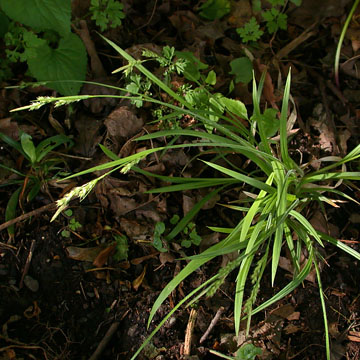

Carex hirtifolia - (image 1 of 5)
Taxonomy
Family: Cyperaceae
Section Hirtifoliae
Synonymous with C. pubescens
Habitat
Rich upland and floodplain forests, thickets.
Associates
Distribution
New Brunswick and Quebec to VA, TN and MS, west SD to TX.
Morphology
Loosely tufted perennial; stems 30-60 cm, pilose, scabrous distally; leaves softly hairy, 4-8 mm wide, the 2 mid-lateral veins conspicuous on the upper side; spikes 2-4, approximate or the lower somewhat separate; lowest bract sheathless, with blade surpassing the spike; upper bracts smaller; terminal spike staminate, slender, 1-2 cm; lateral spikes pistillate, sessile or short-peduncled, 8-15 mm; pistillate scales obovate, with broad hyaline margins and green midvein excurrent into a short awn about equaling the perigynium; perigynia trigonous, hairy, nerveless, the body obovoid, 2.6-3.5 mm long, abruptly rounded into a slender erect beak 0.8-1.3 mm; achene trigonous, filling the perigynium.
Notes
Fruiting May to July
Wetland indicator: NA
A fairly distinctive sedge in that the leaf blades, sheaths, culms and perigynia are all pubescent rather than one or a few of these parts as in other species. Fairly local in distribution, preferring somewhat disturbed habitats.
References
Ball, P.W. and A.A. Reznicek. 2002. Carex, In: Flora of North America Editorial Committee, Eds. Flora of North America North of Mexico. Volume 23. Oxford University Press, New York.
Gleason, Henry A. and A. Cronquist. 1991. Manual of Vascular Plants of
Northeastern United States and Adjacent Canada. Second Ed.
The New York Botanical Garden. Bronx, NY
|
© Michael Hough 2018 |